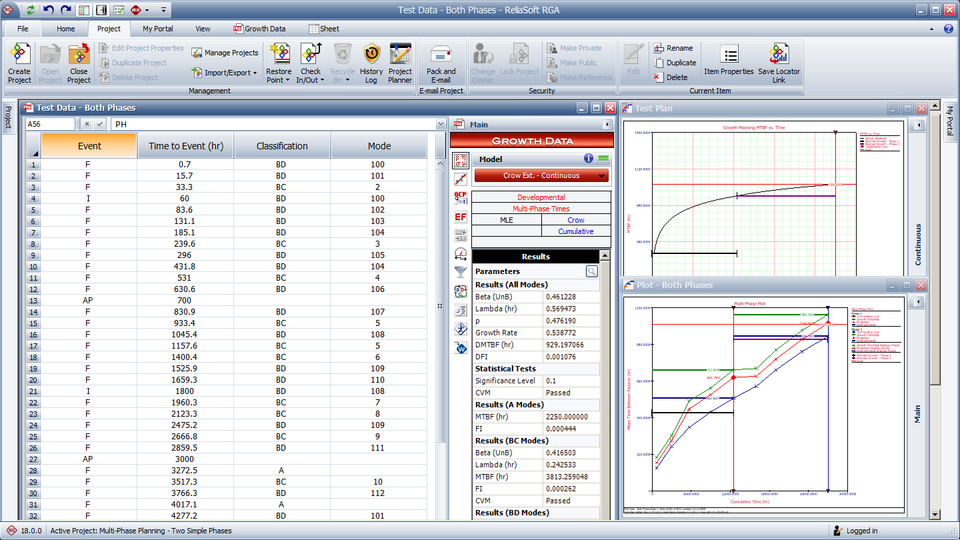
The software is available in two versions and both provide a complete array of utilities for designing accelerated life tests, evaluating the fit of the model, calculating reliability metrics, generating plots and performing related statistical analyses.
ALTA software includes a full set of tools for experiment design and analysis (DOE) and provides the life-stress relationships required to analyze accelerated life test data with up to 8 simultaneous stress types, where stress is constant or varies with time.
- Quantitative Accelerated Life Testing (QALT) can help to significantly reduce test times and produce more robust designs.
- Analyze accelerated life test data with up to 8 simultaneous stress types, where stress is constant or varies with time.
- Flexible results, plots and automated reports to quickly provide the results, plots and reports you need to support decisions based on analysis results. Plots can be annotated and exported as graphic files for use in your reports and presentations. Automated report generation is also available.
- Complete array of QALT analysis capabilities, such as accelerated degradation analyses, accelerated life test plan, data analysis with the Weibull, lognormal and exponential distributions.
- Integration with nCode GlyphWorks for utilizing actual stress profiles.
- Supports a variety of experiment design types, including factorial and fractional designs, Taguchi robust designs, response surface method designs and reliability DOE.
ReliaSoft Training >>
ReliaSoft Resources >>
Request a Trial >>
Overview
In the development stage, the software allows you to quantify and track the system’s reliability growth across multiple test phases, while also providing advanced methods for reliability growth projections, planning and management.
For systems operating in the field, RGA allows you to calculate optimum overhaul times and other results without the detailed data sets that normally would be required for repairable system analysis.
The development of RGA was a joint effort between ReliaSoft and Dr. Larry Crow, the leading authority in the field of reliability growth analysis, along with key development partners in government and industry. This collaboration has resulted in an application-oriented software package with all of the major reliability growth models, plus formulations that are not available anywhere else.
- Project the MTBF or reliability based on planned improvements to the system.
- Quantify reliability growth across multiple test phases.
- Determine the feasibility of achieving a target MTBF with a given management testing strategy.
- Evaluate the reliability improvement that you can expect from rolling out fixes for a fleet of units operating in the field.
- Calculate optimum overhaul times and other results for fielded repairable systems without the detailed data sets that would normally be required for repairable system analysis.
Benefits
- Facilitates reliability growth projections, reliability growth program planning and multi-phase reliability growth analysis.
- Includes traditional reliability growth analysis using the applicable models, such as Crow-AMSAA (NHPP), Crow Extended and Crow Extended-Continuous Evaluation.
- Supports a variety of developmental data types (time-to-failure, discrete (success/failure) and reliability data).
- Helps to create operational test plans that effectively balance all of the mission profiles that need to be tested.
- Provides opportunities for fielded repairable system analysis, including a method for analyzing the system’s reliability behavior over time and discrete and one-shot analysis.
Capabilities
Reliability Growth Analysis
RGA supports all of the traditional reliability growth analysis models:
- Crow-AMSAA (NHPP)
- Duane
- Standard and Modified Gompertz
- Lloyd-Lipow
- Logistic
Reliability Growth Projections, Planning and Management
The software supports several innovative approaches that expand upon traditional reliability growth methods in ways that better represent real-world testing practices and practical applications.
- The Crow Extended model allows you to classify failure modes based on whether and when they will be fixed. This allows you to make reliability growth projections and evaluate the reliability growth management strategy.
- The Growth Planning Folio helps you to create a multi-phase reliability growth testing plan. In addition, you can use the Crow Extended – Continuous Evaluation model to analyze data from multiple test phases and create a Multi-Phase Plot to compare your test results against the plan. This will help to determine if it is necessary to make adjustments in subsequent test phases in order to meet your reliability goals.
- The Discrete Reliability Growth Planning folio allows you to develop the overall strategy for one-shot devices.
- The Mission Profile Folio helps you create a balanced operational test plan and track the actual testing against the plan to make sure the data will be suitable for reliability growth analysis.
Data Types
Times-to-Failure Data: When you have data from developmental testing in which the systems were operated continuously until failure, you can use the Crow-AMSAA (NHPP) or Duane models. RGA provides a choice of data types for individual or grouped failure times, and also for combining data from multiple identical systems. This can include situations where:
- All systems operate concurrently so the operating time of each non-failed system is the same as the time recorded for the failed system.
- You have recorded the exact operating times for both the failed and non-failed systems.
- You have recorded the calendar date for each failure so the software can estimate the operating times of the non-failed systems based on the average daily usage rate for the relevant time period.
With the Crow-AMSAA (NHPP) model, RGA offers additional analysis options for certain situations.
- Gap Analysis: If you believe that some portion of the data is erroneous or missing, this feature allows you to retain the gap interval’s contribution to the total test time without making assumptions about the actual number of failures during that time period.
- Change of Slope: If a major change in the system design or operational environment has caused a significant change in the failure intensity observed during testing, a single model may not provide a good fit for the data. In such cases, RGA can split the data into two segments and apply a separate Crow-AMSAA (NHPP) model to each segment.
Discrete Data (Also Called Attribute, One-Shot or Success/Failure Data): When you have data from one-shot (pass/fail) reliability growth tests (and depending on the data type), RGA supports Mixed data models that can be used with Crow Extended and Crow Extended-Continuous Evaluation models. For discrete data, the software provides a choice of data types that can handle tests in which a single trial is performed for each design configuration, multiple trials per configuration, or a combination of both. RGA also supports Failure Discounting if you have recorded the specific failure modes from sequential one-shot tests.
Reliability Data: When you simply wish to analyze the calculated reliability values for different times/stages within developmental testing, you can use the Standard Gompertz, Modified Gompertz, Lloyd-Lipow or Logistic models.
Failure Mode Classifications and Effectiveness Factors
Although traditional reliability growth analysis requires the assumption that all design improvements are incorporated before the end of the test (test-fix-test), many real-world testing scenarios may also include some failure modes that are not fixed, and others where some or all of the fixes are delayed until a later time (test-fix-find-test or test-find-test). With the Crow Extended and Crow Extended – Continuous Evaluation models, you can use Failure Mode Classifications to provide the appropriate analysis treatment for any of these management strategies. For delayed fixes, both models use Effectiveness Factors to indicate how much the failure intensity of each mode will be reduced once the fix has been implemented.
Reliability Growth Analysis Results, Plots and Reports
For traditional reliability growth analysis you can calculate the MTBF, failure intensity or reliability for a given time/stage. The software allows you to determine the amount of testing that will be required to demonstrate a specified MTBF, failure intensity or reliability. Additionally you can estimate the expected number of failures for a given time/stage. The Quick Calculation Pad (QCP) provides a “Calculation Log” allowing you to record the results from a series of different calculations and then copy/paste the information as needed.
The RGA application makes it easy to create a complete array of plots and charts to present your analysis graphically:
- The Plot Setup allows you to completely customize the “look and feel” of plot graphics while the RS Draw metafile graphics editor provides the option to insert text, draw objects or mark particular points on plot graphics. You can save your plots in a variety of graphic file formats for use in other documents.
- Overlay Plots allow you to plot the results from multiple data sets together in the same plot. This can be an effective visual tool for comparing different data sets or analysis methods.
- Side-by-Side Plots utility allows you to view (and print) multiple plots for a given data set side-by-side
Customizable reports: The Synthesis Workbook is a custom reporting tool that is built into RGA. It seamlessly integrates spreadsheet and word processing capabilities while enabling you to include calculated results and plots from your analysis.
Fielded Repairable System Analysis
RGA also provides opportunities for fielded repairable system analysis.
- Repairable Systems Analysis: Some of the models in RGA can be used to analyze data from repairable systems operating in the field under typical customer usage conditions. Such data might be obtained from a warranty system, repair depot, operational testing, etc. Specifically, you can use the Power Law or Crow-AMSAA (NHPP) models for repairable system analysis based on the assumption of minimal repair (i.e., the system is “as bad as old” after each repair) to calculate a variety of useful metrics, including:
- You can also use the Crow Extended model for fielded repairable systems if you want to evaluate the improvement (i.e., the jump in MTBF) that could be achieved by rolling out a set of fixes for all systems operating in the field.
- Reliability Test Design for Repairable Systems: The test design utility in RGA has been designed specifically for repairable systems. This tool uses the NHPP model to determine the test time required per system (or the number of systems that must be tested) in order to demonstrate a specified reliability goal, defined in terms of MTBF or failure intensity at a given time.
- Operational Mission Profiles: When a system must be tested for a variety of different operational mission profiles, it can be a challenge to make sure that the testing is applied in a balanced manner that will yield data suitable for reliability growth analysis. RGA’s Mission Profile folios can help you to create an operational test plan, track the expected vs. actual usage for all mission profiles and verify that the testing has been conducted. It helps you automatically group the data at specified “convergence points” so the growth model can be applied appropriately.
Monte Carlo Simulation
You can use the RGA Monte Carlo Data Generation feature to create data sets that can be analyzed directly in one of RGA’s standard folios. You can also use the SimuMatic® utility to automatically analyze and plot results from a large number of data sets that have been created via simulation. These integrated simulation tools can be used to perform a wide variety of reliability tasks, such as:
- Designing reliability growth tests.
- Obtaining simulation-based confidence bounds.
- Experimenting with the influences of sample sizes and data types on analysis methods.
- Evaluating the impact of allocated test time.
What's New in Version 2019
MIL-HDBK-189
Starting in Version 2019, the MIL-HDBK 189 planning model is available in the Continuous Growth Planning folio.
Expected Fleet Failures calculation
The Expected Fleet Failures calculation is the number of failures that are expected to occur for all systems by a specified time. This option is available only for fielded repairable data and for fielded fleet data.





